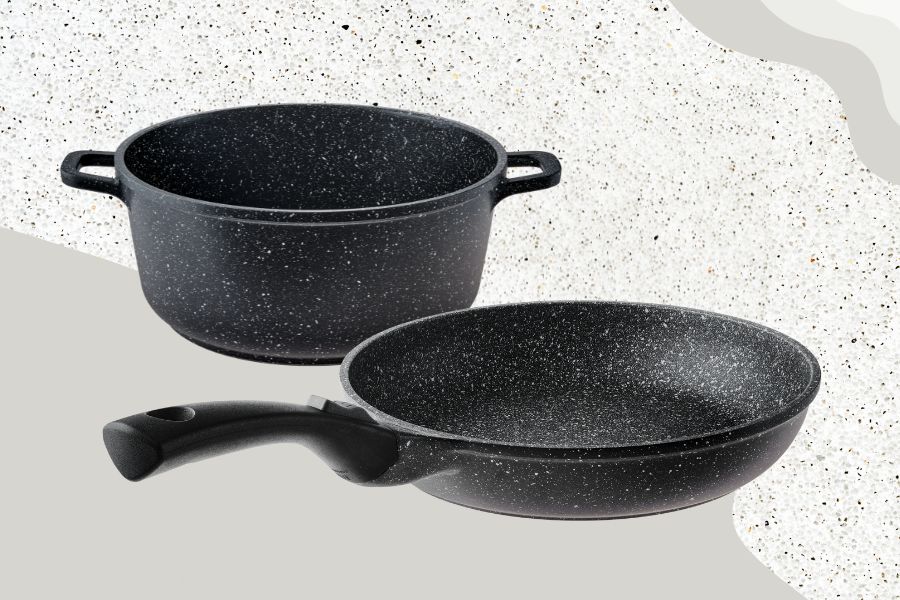As someone who loves to cook, I’ve often wondered about the safety of various cookware materials. Recently, my curiosity has been piqued by granite cookware. It’s loved by many for its durability, non-stick properties, and sleek, modern look. But just how safe is it?
In this article, we’ll delve into what granite cookware is made of and explore any potential health concerns. We’ll also provide some handy tips on safely using and maintaining your granite pots and pans, ensuring they last for years.
Furthermore, we’ll compare granite and stainless steel cookware and suggest some alternatives for those considering a switch. So stick around if you’re like me, always on the lookout for reliable and safe kitchen tools. This article aims to give you all the information you need to make an informed choice about granite cookware.
Is Granite Cookware Safe?
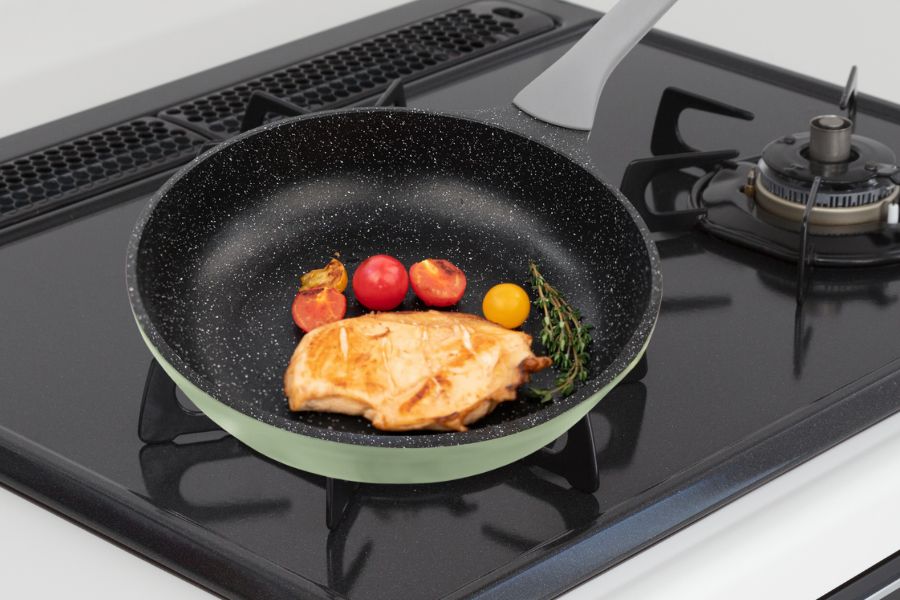
A study published in the Journal of Food Science in 2015 found that granite cookware is safe to use. The study found that the cookware’s granite coating does not release harmful chemicals or toxins into food, even when cooked at high temperatures.
As a cooking enthusiast, I’m always curious about the safety of different types of cookware, especially granite. I’m particularly interested in PTFE-coated granite cookware and vitreous enamel-coated granite cookware.
These have unique characteristics that impact their safety and effectiveness in the kitchen. I’m eager to delve into the specifics to help you decide your cookware.
1. PTFE-Coated Granite Cookware
You might be surprised to learn that most PTFE-coated granite cookware is now made without the harmful chemical PFOA, making your cooking experience safer and more enjoyable.
This is a significant shift in the culinary industry that provides peace of mind when whipping up your favorite dishes.
Moreover, this evolution in manufacturing has sparked a critical conversation around the question, ‘Is granite cookware safe?’ With the elimination of PFOA, the answer is increasingly positive.
PTFE-coated granite cookware offers a high-performing, non-stick surface free from potential health hazards. It’s a win for your culinary adventures and a victory for your health.
So, go ahead and cook freely, knowing that your PTFE-coated granite cookware is safe and enhances your overall cooking experience.
2. Vitreous Enamel-Coated Granite Cookware
Switching gears to vitreous enamel-coated kitchenware, it’s not just about functionality but also about bringing an aesthetic appeal to your kitchen. Vitreous enamel-coated granite cookware takes the best of both worlds – the granite’s robustness and the vitreous enamel’s resilience.
This cookware is pleasing to the eye but remarkably durable and resistant to high temperatures. More importantly, it’s devoid of harmful chemicals like PFOA. So you’re not just getting visually appealing cookware but one safe for you and your loved ones.
Therefore, granite cookware coated with vitreous enamel is safe and reliable. It’s perfect for those who desire freedom in their cooking style without compromising health or style.
What Is Granite Cookware Made Of?
Ever wonder what your granite cookware is made of? It’s not actual granite stone but rather a blend of aluminum and a non-stick coating that’s been infused with tiny granite particles.
This unique combination ensures a cooking surface that heats up quickly and evenly, thanks to aluminum’s excellent heat conductivity. Plus, the infusion of granite in the non-stick coating provides a tougher, more durable surface and an appealing, earthy look.
The non-stick coating, usually made of PTFE, a type of non-stick plastic, ensures that your food doesn’t stick to the pan, making it a breeze to clean up after. The durability of this cookware, together with its high-quality cooking surface, makes it an asset in any kitchen.
How To Ensure Health Safety While Using Granite Cookware?
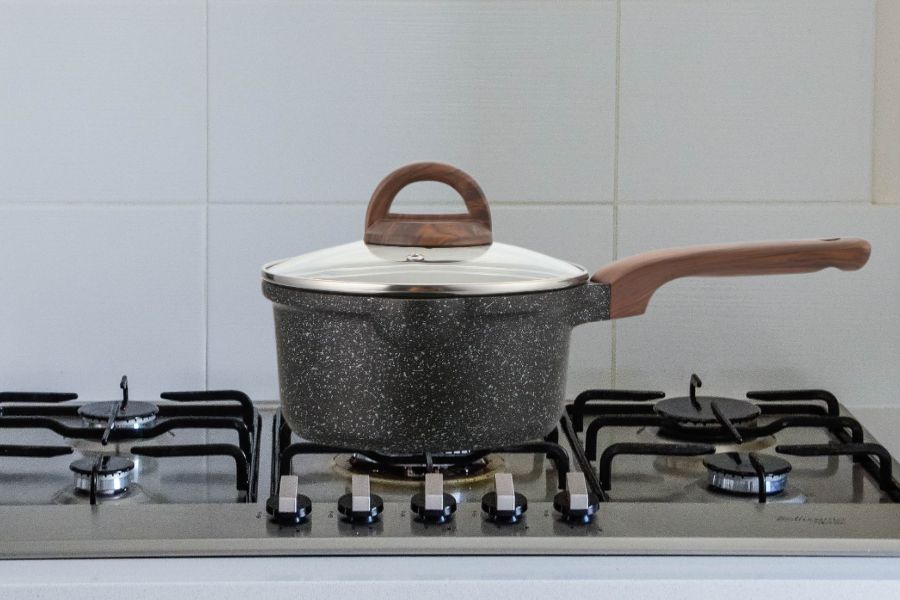
As a careful and mindful cook, I always select granite cookware free of harmful chemicals to safeguard my family’s health. I take extra precautions not to heat the cookware when it’s empty or use high heat, and I avoid using metal utensils on the non-stick coating to maintain its integrity.
After cooking, I gently clean the cookware by hand using mild soap and water, and if I notice the non-stick coating starting to peel or chip, I discard the cookware immediately.
1. Choose Cookware that Is Free of Harmful Chemicals.
You’ll sigh in relief knowing that granite cookware is typically free of harmful PFOA and PTFE chemicals, providing a safer environment for your family’s meal times. This cookware safety isn’t just a minor selling point; it’s a major advantage with serious implications for your health and peace of mind.
I can’t stress enough the importance of choosing cookware free of these harmful chemicals. Not only can they cause serious health issues, but they also compromise the taste and quality of your food.
So, when shopping for new pots and pans, look for those labels: ‘PFOA-free’ and ‘PTFE-free.’ It’s a small step that makes a big difference in ensuring your kitchen is a haven of safety and freedom from harmful toxins.
2. Do Not Heat the Cookware Empty or Over High Heat.
Avoiding high heat and not heating your pots and pans when they’re empty is crucial, as this can cause the non-stick coating to break down and release harmful fumes. It’s vital to remember that your cookware’s heat resistance isn’t infinite. Exposing your pots and pans to exceptionally high temperatures can degrade the non-stick coating, potentially releasing it into your food or the air you breathe.
This isn’t just about maintaining the longevity of your cookware but also about ensuring your safety. So, when selecting your next set of pots and pans, check their heat resistance and choose the ones that can withstand the heat settings you commonly use.
Remember, cookware free of harmful chemicals and handles heat well is key to a safe and free cooking experience.
3. Do Not Use Metal Utensils with The Non-Stick Coating.
When whipping up your favorite dish, it’s crucial not to use metal utensils on the non-stick coating, as they can cause serious damage.
You see, the ceramic coating on our granite cookware is specially designed for scratch resistance. However, metal utensils can be too harsh and may potentially scratch the surface, making the cookware more susceptible to releasing harmful chemicals.
Think about it this way: you’re not just protecting your cookware but your health and your freedom to cook safely and effectively. So, opt for wood, silicone, or plastic utensils instead of metal. They’re gentler on the non-stick surface, ensuring its longevity.
Remember, well-cared-for granite cookware can be your kitchen companion for years.
4. Wash the Cookware by Hand with Mild Soap and Water.
To ensure your non-stick pans and pots maintain their optimum condition, it’s best to gently wash them by hand with a bit of mild soap and warm water, envisioning the suds softly caressing the smooth surface. It’s not only a matter of preserving the quality of your cookware but also fundamental for food safety.
Avoiding harsh cleaning methods, such as using a dishwasher or abrasive scrubbers, is crucial in maintaining the integrity of the non-stick coating and, ultimately, the safety of your meals.
The cleaning instructions are straightforward. After cooking, let the cookware cool down, then wash it by hand. Use a soft sponge or cloth, ensuring you’re not scratching the surface. This simple routine allows you to enjoy your granite cookware for years to come worry-free.
5. Discard the Cookware if The Non-Stick Coating Starts to Peel or Chip.
Sadly, if you notice the non-stick coating of your pans and pots starting to peel or chip, it’s time to part ways. This isn’t just about aesthetics but also about your health. When the coating gets damaged, it might release harmful chemicals that could compromise your well-being.
For instance, granite cookware often contains PFOA, a compound known for its potential toxicity. The best course of action here is to discard the cookware. Don’t attempt to continue using it, hoping that the situation might improve. It won’t. In fact, it could get worse.
Replace it with PFOA-free options – they’re much safer and still provide that non-stick convenience. Remember, your health and freedom from harmful substances should always be a priority.
Tips for Prolonging the Life of Your Granite Cookware
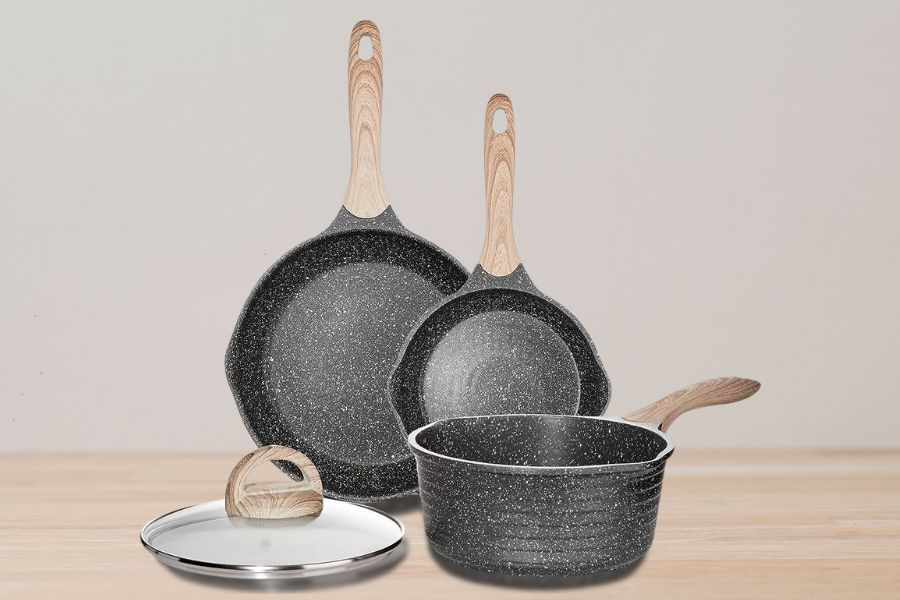
As a proud owner of granite cookware, I’ve learned some valuable tricks to help keep it in top-notch condition and extend its lifespan.
It all starts with choosing the right piece for each cooking task, adjusting the heat setting appropriately, and opting for utensils that won’t scratch or damage the surface.
Crucial, too, are washing it by hand and letting it cool down completely before cleaning, which can significantly help prevent unnecessary wear and tear.
Choose the Right Cookware for The Job.
Choosing the right cookware isn’t just about style or price; it’s about ensuring the safety and quality of your meals. Regarding granite cookware, I need to consider the job at hand.
Not all granite cookware is created equal. Some are better for certain types of cooking than others. For instance, if I’m cooking acidic foods, I’ll select cookware with a non-stick coating resistant to acids. This way, I’m free from health concerns related to heavy metal leaching, which can occur with the wrong cookware.
This knowledge empowers me to make better choices, ensuring I’m cooking delicious meals and caring for my health and well-being. It’s about the freedom to cook fearlessly, knowing I’ve chosen the right tool for the job.
Use the Right Heat Setting.
Getting the heat setting right is about more than whipping up a great meal. It’s also a clever move to protect your non-stick pots and pans. This is particularly true for those of us who love our granite cookware. These beauties aren’t only FDA-approved but also provide an excellent, even heat distribution perfect for cooking.
However, they come with a caveat: they don’t handle excessive heat well. Overheating them can damage the non-stick coating, affecting their performance and safety. Therefore, it’s crucial to start with a low heat setting and gradually crank up the heat as needed.
This way, I preserve my cookware and ensure I’m cooking safely and healthily.
Use the Right Utensils.
When it comes to stirring up a storm in your kitchen, remember your choice of utensils is just as important!
Using the right tools makes your culinary endeavors easier and can extend the life of your precious granite cookware.
Now, you might wonder, why not use metal utensils? Metal can scratch the non-stick coating on your granite ware, making it more prone to degrade over time.
Instead, I’d recommend opting for silicone or wooden utensils. They’re gentle on your cookware and won’t compromise the non-stick surface.
Remember, safety and durability go hand-in-hand. By making the right choices, you’re protecting your investment and ensuring a safer cooking experience.
So, unleash your inner chef, but remember to do so with the right tools!
Wash the Cookware by Hand.
After a delightful session of culinary creativity, it’s time to treat your non-stick pots and pans with the gentle touch they deserve. Hand washing them is the way to go.
You see, your granite cookware isn’t just another kitchen tool. It’s a culinary partner that needs a little TLC to keep it in top shape.
Throwing them in the dishwasher might seem like an easy option, but this can be a recipe for disaster. The harsh detergents and scalding water can wreak havoc on the non-stick coating, diminishing its efficiency and potentially making it unsafe.
Remember, maintaining its integrity is essential to keeping granite cookware safe. So, let’s skip the dishwasher and opt for a gentle hand wash. It’s worth the extra effort to ensure safety and prolong the life of your cookware.
Let the Cookware Cool Down Completely Before Washing It.
Before you rush to clean up, let your pots and pans cool down completely. This is crucial in preserving the integrity of your granite cookware. Trust me, I’ve learned from experience that the sudden temperature change from hot to cold can potentially damage the non-stick coating of your precious pots and pans.
Remember, granite cookware is known for its durability and heat distribution but is not invincible to harsh treatment. So, step back, let your cookware cool down after cooking, and then clean it gently by hand.
This technique maintains the quality of your cookware and reinforces your freedom to cook whenever you want without worrying about damaging your tools. It’s a simple habit that can make a world of difference.
Store the Cookware Properly.
Ensuring your pots and pans are properly stored isn’t just about keeping your kitchen tidy; it’s also about extending the lifespan of your favorite culinary tools.
When it comes to my granite cookware, I’ve learned that it’s all about keeping it dry and moisture-free. The last thing I want is for the non-stick coating to break down because of a little water left behind.
I thoroughly dry my granite pots and pans after washing them. I don’t rush it either – I take my time to ensure every nook and cranny is moisture-free before I put them away. It’s a small step that makes a big difference in preserving the quality of my cookware.
Proper storage isn’t just about keeping your cookware dry, though. It also means keeping them in a cool, dry place away from extreme temperatures. This way, I ensure my granite cookware stays safe, functional, and ready for my next culinary adventure.
It’s all about the freedom to cook confidently, knowing that my tools are well-maintained and ready for action.
Granite Cookware vs. Stainless Steel
| Material | Pros | Cons |
| Granite cookware | Easy to clean, non-stick, lightweight | Not as durable, can be damaged if not used properly |
| Stainless steel | Durable, heat resistant, versatile | Not as non-stick, can be difficult to clean if food sticks to the pan |
I’ve always been torn between granite cookware and stainless steel as a home cook. Both have unique benefits and drawbacks; deciding which suits my culinary needs can be tough.
So, let’s dive right in and explore the world of granite cookware versus stainless steel. We’ll compare their durability, heat distribution, and overall cooking performance.
Granite Cookware
You’ll find that granite cookware, while less durable than some other materials, can be a safe and effective choice for your kitchen with proper use and care. Its non-stick coating is infused with tiny granite particles, making it a breeze to clean up after meals. Food won’t cling to it, saving you time and effort.
It’s also relatively lightweight, so you won’t strain your wrists flipping pancakes or sautéing veggies. However, it’s not invincible – carelessness can lead to damage. But with mindful use, it’s a reliable option.
So, if you value ease and convenience in your cooking routine, granite cookware can be a great addition to your kitchen arsenal. It’s all about the freedom to cook without the fuss.
Stainless Steel
On the other hand, imagine handling a set of stainless steel pots and pans in your kitchen, their sleek surface glistening under the lights, radiating robustness and durability.
It’s not just about the look; it’s about the performance. You see, stainless steel cookware is incredibly versatile. Whether searing a steak or simmering a soup, these pots and pans are up to the task. They’re renowned for their heat resistance, allowing you to crank up the heat without worrying about warping or discoloration.
And talk about durability! These utensils are built to last, withstanding the test of time. But, they do have their drawbacks. Food can stick, and it can be a challenge to clean.
Despite that, their benefits are worth considering if you seek freedom in your culinary adventures.
Some Alternatives to Granite Cookware
If you’re not completely sold on granite cookware, don’t worry. There are plenty of alternatives to consider.
1. Stainless Steel Cookware
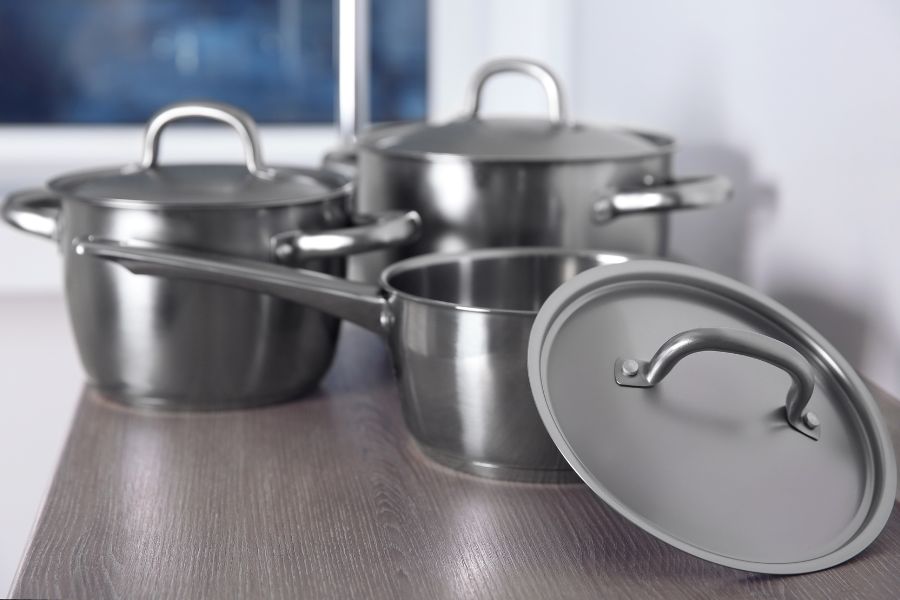
Don’t underestimate the value of stainless steel cookware; it’s durable, versatile, and a relatively safe option for your cooking needs.
If you’re seeking a reliable companion for your culinary adventures, nothing beats the longevity of this material. It defies wear and tear like a champ, making it an ideal choice for frequent cooking. It’s also a breeze to clean, saving you precious time and energy.
The non-stick feature of stainless steel is less pronounced than in granite cookware, but it’s good enough for most cooking tasks. It’s a healthier choice, eliminating the risk of chemicals leaching into your food.
So, if you value your freedom to cook safely and efficiently, stainless steel cookware is the way to go.
2. Cast Iron Cookware
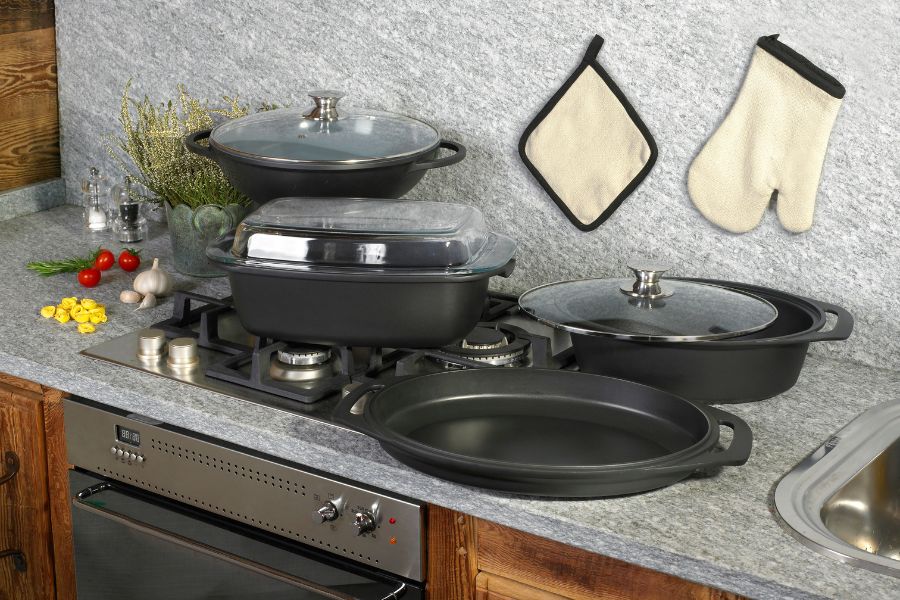
Imagine you’re in your kitchen, sizzling steak wafting through the air as your trusty cast iron skillet sears it to perfection.
There’s something earthy and authentic about cast iron cookware. It’s not just a pan; it’s a culinary companion built to last.
I appreciate its rugged durability and how it can withstand high heat, making it ideal for everything from frying to baking. Plus, it’s naturally non-stick once properly seasoned, a process that might take some time but is well worth it.
And let’s remember its affordability. It’s a real steal, considering its versatility and quality.
With its rustic charm and practical prowess, cast iron cookware offers a sense of freedom in the kitchen, and I wouldn’t trade it for anything.
3. Ceramic Cookware
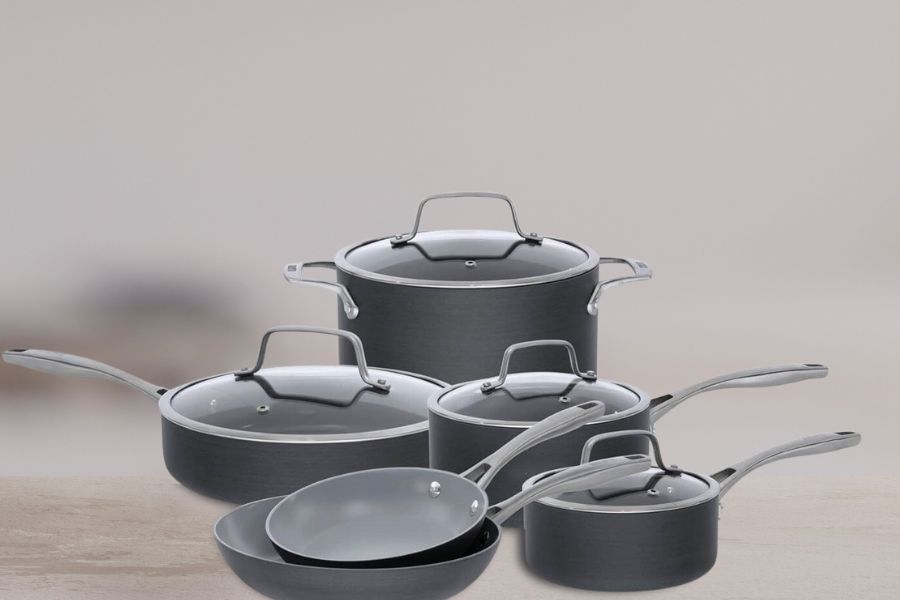
You’re going to love the ease and elegance of ceramic. It’s like a breath of fresh air in your culinary journey, offering a non-stick surface that’s a breeze to clean, not to mention the peace of mind of knowing it’s devoid of harmful toxins.
Ceramic cookware is a real game-changer. It’s infused with ceramic particles, giving it that wonderful non-stick quality. You’ll find that your food won’t cling to the pan, making clean-up quick and simple.
And it’s not just about convenience. Ceramic cookware is a healthy choice, too. It’s free from PTFE, a substance associated with certain health risks. So, with ceramic, you’re cooking with ease and freedom. Freedom from stubborn food particles, strenuous cleaning, and health worries.
It’s truly a liberating culinary experience.
4. Carbon Steel Cookware
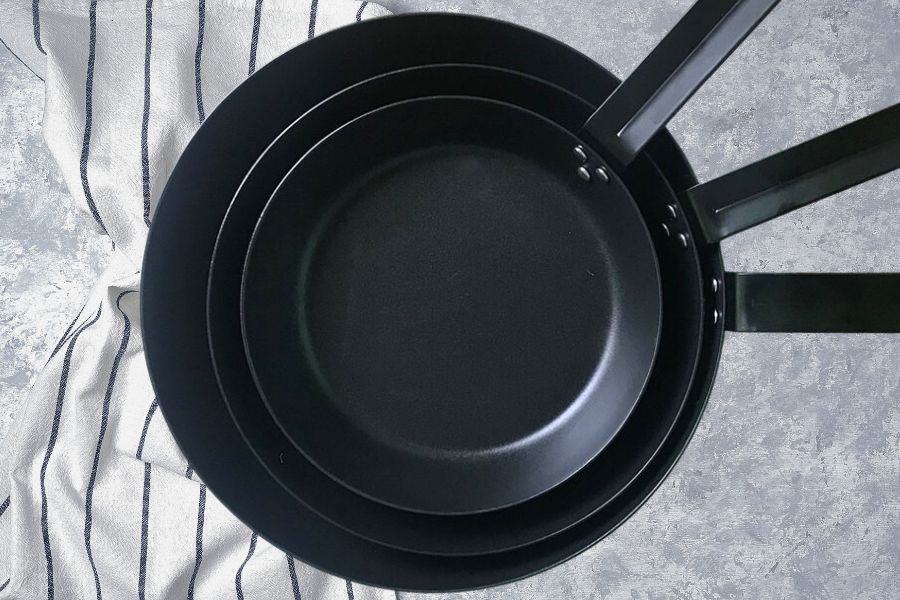
Think about the sizzle and sear you could achieve with carbon steel in your kitchen—it’s known for its exceptional heat conductivity, making it perfect for cooking those delicate dishes. This steel heats up quickly and evenly, ensuring every bite is perfectly cooked.
But the benefits continue. Carbon steel cookware is also naturally non-stick—a feature that makes cooking and cleaning a breeze. It might take some time to season it properly, but the result’s worth it.
Plus, the longevity of carbon steel cookware is a big bonus, which means you’re investing in a product that will last.
So, if you’re seeking the freedom to cook like a pro, carbon steel cookware is the way to go.
5. Enameled Cast Iron Cookware
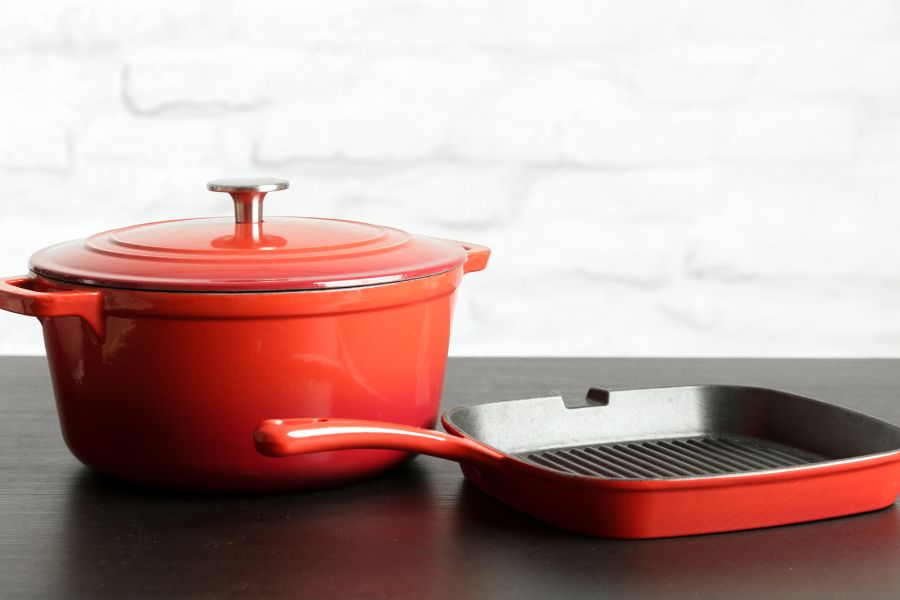
Having explored the nitty-gritty of carbon steel cookware, let’s delve into the realm of enameled cast iron cookware. It’s quite an interesting addition to our culinary arsenal.
Unlike traditional cast iron pots and pans, the enameled cast iron variety is coated with enamel. This not only makes these pieces more robust but also simpler to clean. The enamel layer also imparts a naturally non-stick quality to the cookware. This is a huge plus for those wary of the potential health risks associated with PTFE.
If you’re seeking cookware that balances durability, ease of maintenance, and health-conscious properties, enameled cast iron cookware might be your ticket to the freedom you desire in your kitchen.
FAQs
Is Granite Safer than Non-Stick?
It depends on the type of non-stick coating. Some non-stick coatings, such as PFOA and PTFE, have been linked to health concerns. However, many granite cookware brands now use non-toxic coatings that are free of PFOA and PTFE. So, choosing granite cookware with a non-toxic coating can be just as safe as non-stick cookware.
Does Granite Stone Cookware Contain PFOA?
Some granite cookware may contain PFOA, but many brands now use non-toxic coatings that are free of PFOA. If you are concerned about PFOA exposure, it is important to choose granite cookware that is labeled as “PFOA-free” or “PTFE-free.”
Why Granite Cookware Is Not Used in the Kitchen?
There are a few reasons why granite cookware is not as commonly used in kitchens as other types of cookware.
- Price: Granite cookware can be more expensive than other types of cookware.
- Durability: Granite cookware can be more delicate than other cookware and can chip or scratch more easily.
- Heat distribution: Granite cookware does not distribute heat as evenly as other types of cookware, leading to hot spots and uneven cooking.
Conclusion
So, is granite cookware safe? Yes, it is, if used properly. It’s made from a mix of materials, including porcelain enamel and natural stone. Don’t overheat it; always use non-metal utensils to keep it safe. Want it to last? Take good care of it.
But if you still need to figure it out, stainless steel is a good alternative. Ultimately, it’s all about what works best for you in your kitchen.
Also, Check:

